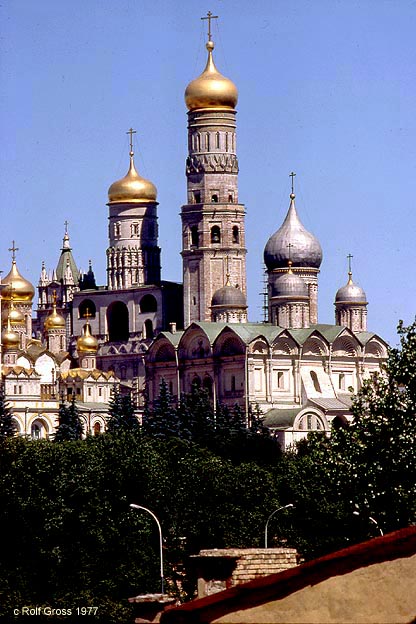
Photo RWFG 1977
The ensemble of the Kreml seen from across the Moskva River.
Moscow
The Kremlin
1147
- 20th cent
Link to
Google-Earth file MoscowKreml.kmz
This requires that you have GE on your hard disc.
History of Moscow
Moscow
is mentioned by the chroniclers for the first time in 1147, when
Prince Yuri Dolgoruki of Suzdal invited Prince Svyatoslav Olgovitch
of Chernigov to visit him there. It long remained a place of no
importance. In 1325 Metropolitan Peter transferred his residence from
Vladimir to Mocow. This example was followed in 1328 by Grand-Prince
Ivan Danilovitch Kalita (1328-10), who was recognized in 1333 by the
Grand-Khan as chief ruler of Russia. He surrounded the town with a
palisade, and gave the name of Kremlin to the castle. Under Demetrius
Donskoi (13B3-89) the town was unsuccessfully besieged (1363) by
Grand-Prince Olgierd of Lithuania, and in 1382 it was laid in ashes
by the il-Khan Tokhlamysh.
During the succeeding period it
was frequently sacked by Mongolian hordes, and did not attain any
great degree of prosperity until the reign of Ivan III. Vasilyevitch
(1462-1505), who made Moscow the center of the now united kingdom,
and beautified it by numerous buildings, and called Italian
architects to rebuild the Kremlin churches. In 1520, during the reign
of Vasili Ivanovitch (1605-33), the town is said to have contained
45,000 dwelling-houses. Under Ivan the Terrible (1533-84) the
vigorous development of the city was interrupted by conflagrations
(in 1647, etc.) and by hostile invasions, as in 1671, when it was
captured by Devlet-Girei, Khan of the Crim-Tartars. In 1553 Ivan
concluded a commercial treaty with Queen Elizabeth of England, after
the landing of Sir Richard Chancellor on the shores of the White Sea.
In 1591 the Tartars, under Kara-Girei, attacked Moscow for the last
time. In 1612 the Poles, who had supported the claim of the False
Demetrius to the throne of the Tsars, were expelled, and in 1613
Mikhail Feodorovitch Romanov, though under seventeen years of age,
was chosen Tsar by the National Assembly.
In 1711 the capital
of the empire was removed to the newly built St. Petersburg, but the
immediate successors of Peter the Great continued to favour the
Kremlin rather than the still undeveloped town on the Neva. In 1748
Moscow was raised to the dignity of an eparchy and in 1755 its
university was founded.
The fate of Moscow in 1812 is
universally known. On Sept. 2nd the Governor, Count Rostopovchin,
with the great majority of the population, left the city. Napoleon
entered it on the same day and on the following day began the
conflagration, which was not subdued until Sept. 6th (18th), when
three-fourths of all the houses in the city lay in ashes.
Adapted
from Karl Baedeker, "Russia", Leipzig, 1914
The
Towers of the Kreml 
Photo RWFG 1977
The ensemble of the Kreml seen from
across the Moskva River.
Dormition
or Assumption Cathedral
1475 - 1479 Uspensky
Sobor
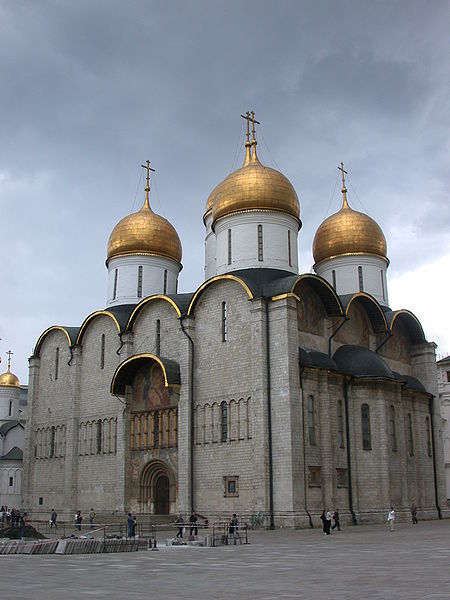
Photo
Wikipedia
Built 1475–1479 by the Italian architect Aristotele
Fioravanti 
Frescoes
in the Dormition Cathedral, 1642-1643.
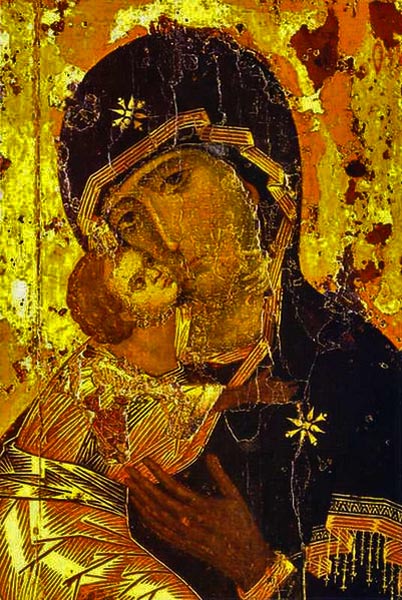
Photo
RWFG 1977
The
icon of Our Lady of Vladimir (Elousa) was purpurtedly painted in the
5th cent in Jerusalem. It came from Constantinople to Kiev in 1122,
from there to Valdimir in 1158. In 1395 the icon was taken to Mocow
to protect the city against Timurleng's hordes. It was housed in the
earlier Assumption Cathedral. Now in the Treyakov Gallery. Only the
faces have never been overpainted.
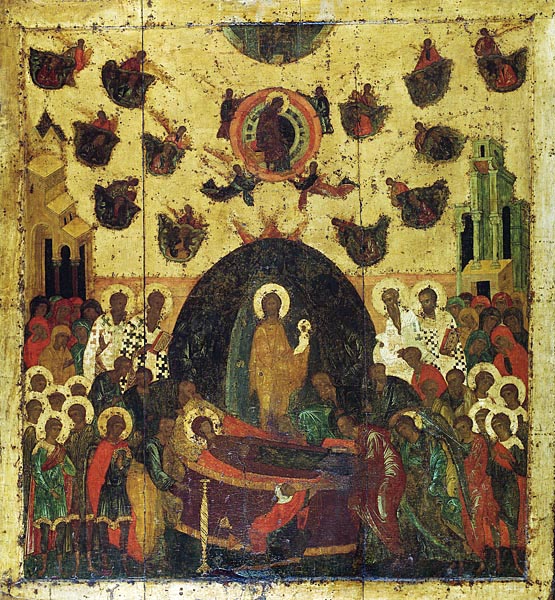
Photo
icon-art.info
The Dormition Icon of the Uspensky Cathedral, 1479, 179 ×
164 cm, Tretyakov Gallery

Photo
icon-art.info
The Last Judgment, Dormition Cathedral, Late 14th-early 15th
centuries, Tretyakov Gallery
The
Church of the Deposition of the Robe
1488
Rizopolozheniya Sobor
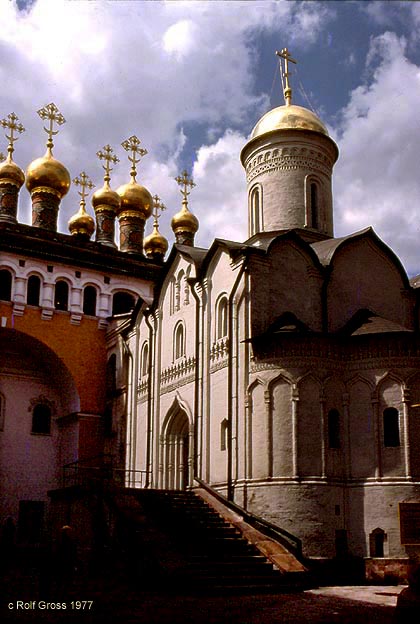
Photo
RWFG 1977
Dwarfed
behind the Cathedral of the Assumption, this tiny church became the
personal chapel of the Moscow Metropolitans and Patriarchs. It was
built in 1484-86 by Pskov craftsmen, on the site of the original
Church of the Deposition of the Robe, which perished in the Kremlin
fire of 1473. The church commemorates the official recognition of the
Moscow Metropolitan as Metropolitan of Kiev and all Russia,
acknowledged in 1451 by Casimir IV, King of Poland and Lithuania.
The church's name refers to the robe of the Virgin Mary, a
prized relic which was held to have saved Constantinople from
attackers on several occasions. Inside the church, there are a number
of frescoes devoted to the governing theme of the church by the
artists Ivan Borisov, Semion Abramov, and Sidor Pospeyev. The
iconostasis, from 1627, is the work of the painter Nazary Istomin
Savin.
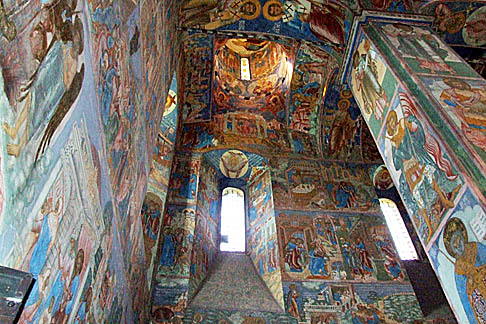
Wall
paintings in the church (1644)
The
Annunciation Cathedral
1489
Blagoveshchenskiy Sobor

Photo
RWFG 1977
The Cathedral was built by architects from Pskov in
1484-1489.
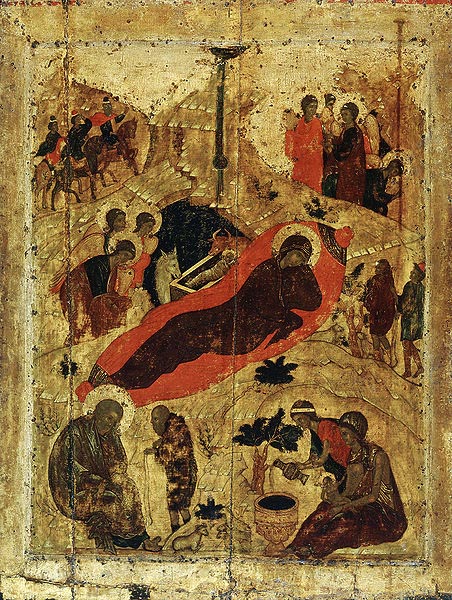
Andrei
Rublyov, Nativity icon from the Feast Days of the Deesis of the
Annunciation Cathedral, 1405
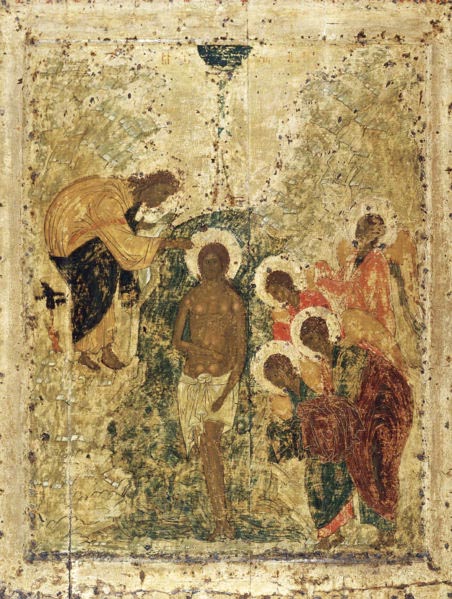
Andrei
Rublyov, Kreshcheniye (Baptism) icon from the Feast Days of the
Deesis, 1406
All icons are now in the Tretyakov Gallery.
Photos of icons RWFG 1977 and 1984
Link
to the
The
Deesis of the Rublyov Iconostasis of the Annunciation Cathedral
The
Archangel Cathedral
1504
- 1508
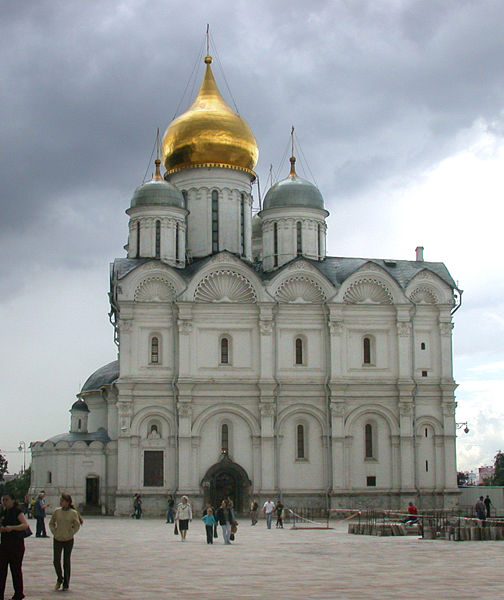
Photo
Wikipedia

Photo
RWFG 1989
The
Bell Tower
1505-1508,
extended in height in 1600
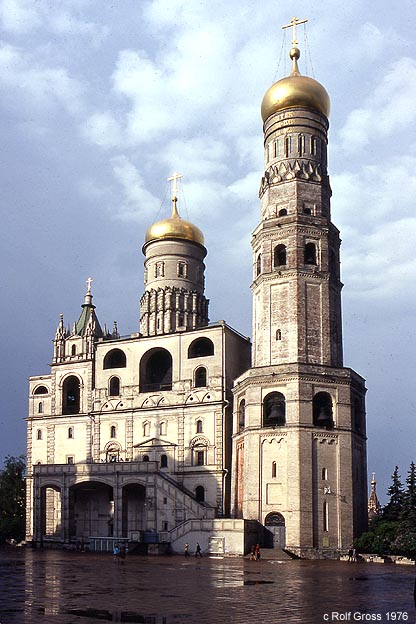
Photo
RWFG 1976
Domes
of the Verkhospassky Churches
1635-1662
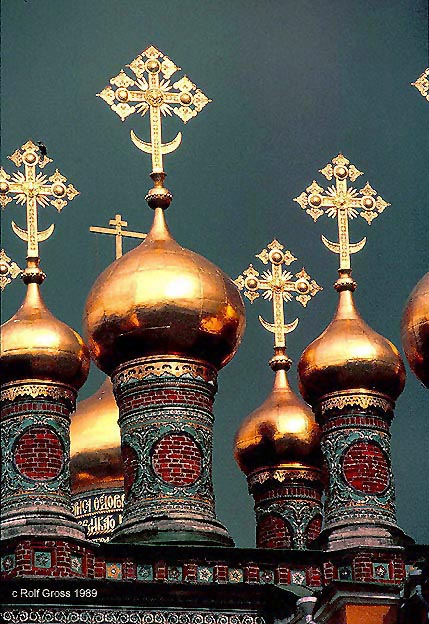
Photo
RWFG 1989
Domes of the Verkhospassky Churches (Upper Churches
of Christ) on top of the Terem Palaces (1635-1662) by Russian
craftsmen
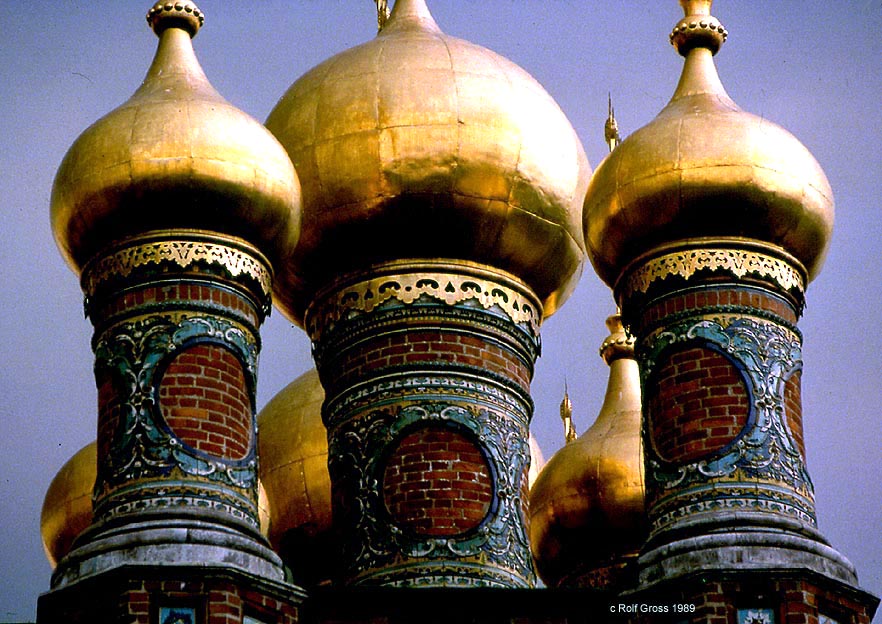
Photo
RWFG 1977
In
1630-1640, the Verkhospasskiy Cathedral and a gallery were built over
the Golden Chamber of Tsarina Irina Godunova's Terem Palace.
Entry
Church of the 12 Apostles
1654-56
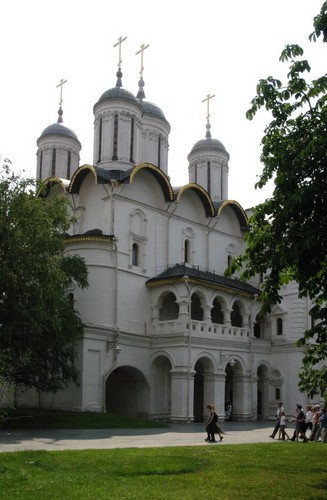
Photo
Sergey Duhanin,
Panoramio
Entry Gate to the Cathedral Square in the
Kreml
The
Golden Roofs of the Annunciation Cathedral
15th
cent
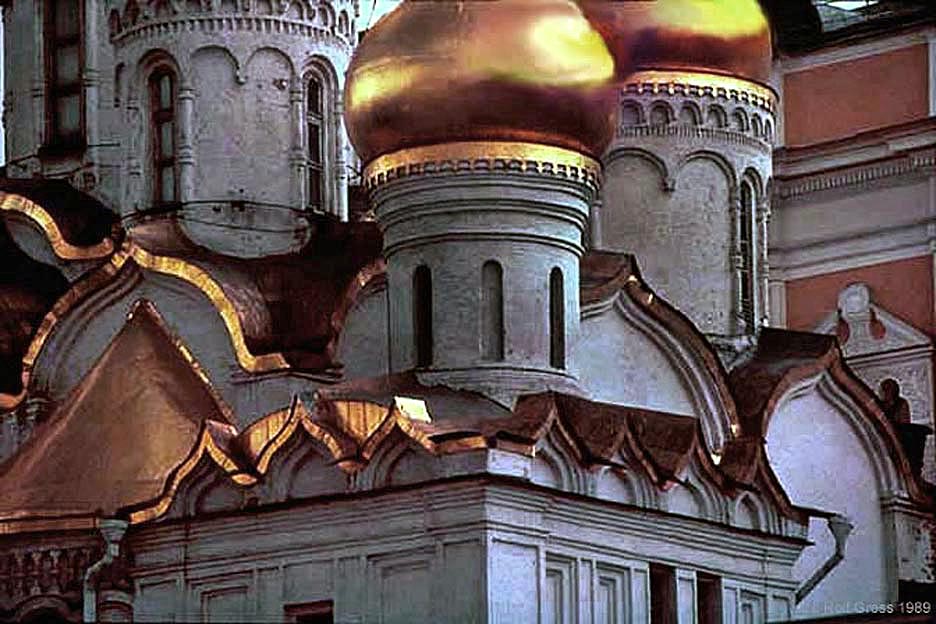
Photo
RWFG 1989
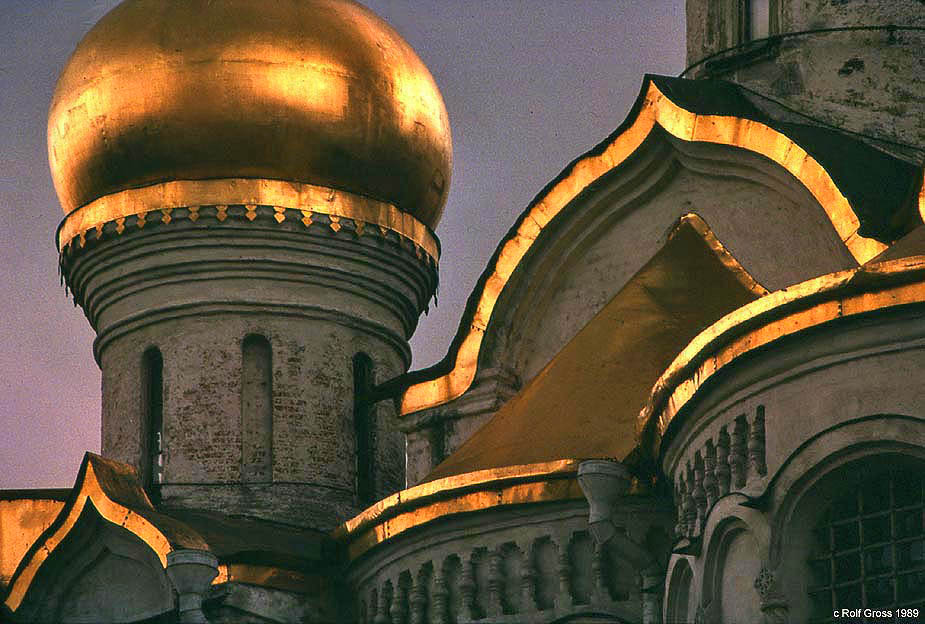
Photo
RWG 1989
The roofs of the Annunciation Cathedral in the last
light of this fantastic evening in 1989
Gate
of Our Savior in 1976
1485
- 1495 Spassky Gate
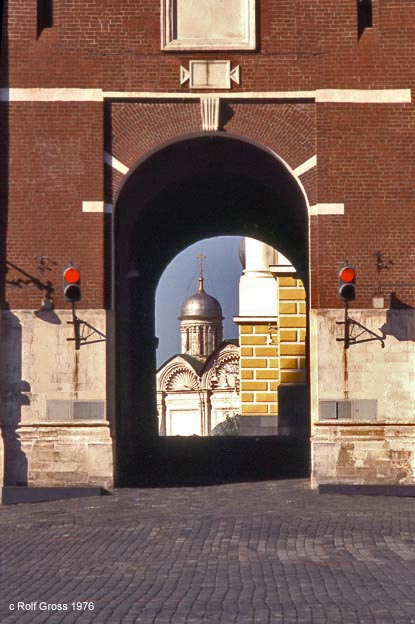
Photo
RWFG 1976
The Gate of Our Savior
Grand
Prince Ivan III organised the reconstruction of the Kremlin, inviting
a number of skilled architects from Renaissance Italy, like Petrus
Antonius Solarius, who designed the new Kremlin wall and its towers.
- As long as they ruled the leaders of the USSR passed daily through
this gate - others were forbidden to enter....
St. Basil's Cathedral
1555-1561, Cathedral of the Intercession of the Most Holy Theotokos
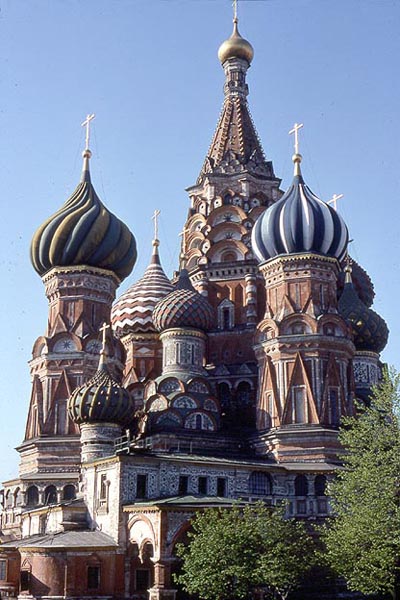
Photo
RWFG 1976
The Cathedral of the Intercession of the Most Holy
Theotokos 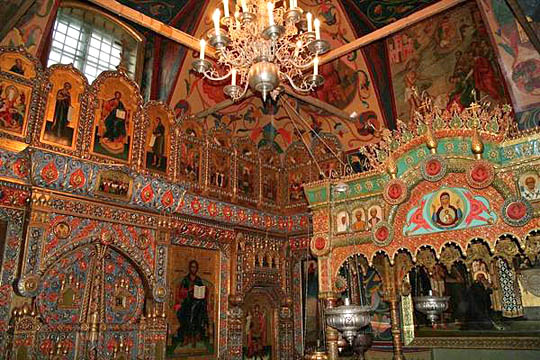
Photo
worldisround.com
The gaily painted interior of St. Basil's (1680–1683).
The
Resurrection Gate
1680,
1996 Voskresensky Vorota
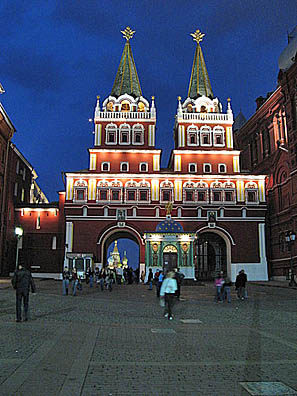
Photo
Panoramio
The
newly re-constructed Resurrection Gate and the Chapel of the of the
Iberian Mother of God.
The Resurrection Gate the entry to the Red Square (also called or Gate of the Iberian Mother of God) is the only surviving gate of the Kitaigorod in Moscow. In 1931, the Resurrection Gate and the Iberian chapel - the small green building in front of the gate - were demolished in Soviet times in order to make room for heavy military vehicles driving through Red Square during military parades. Both structures were completely rebuilt in 1994-1996.

Photo
ocaf.oca.org
A lusterless new icon of the Iverian Theotokos was painted on
Mount Athos by the monk Iamblichos to replace the lost original.
(Does she wear a band of patriotic medals on her right shoulder?)
The
"Red" Square
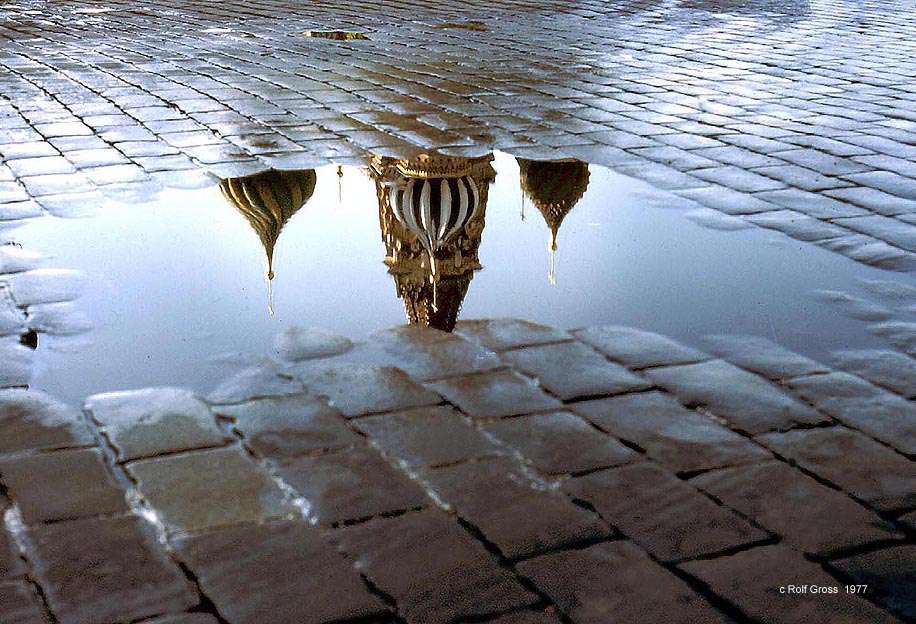
Photo
RWFG 1977
St. Basil's Cathedral reflected in a puddle very
early one morning in 1977.
The
name "Red Square", Krasnaya Ploshad, derives neither from
the colour of the brick buildings surrounding it (which, in fact,
were white-washed at certain points in history) nor from the link
between the colour red and communism. Rather, the name came about
because the Russian word krasnaya” can mean either "red"
or "beautiful" (the latter being archaic). This name, with
the meaning "beautiful", was originally applied to Saint
Basil's Cathedral and was subsequently transferred to the square. It
is believed that the square acquired its current name (replacing the
older “Pozhar”, or "burnt-out place") in the
17th century.